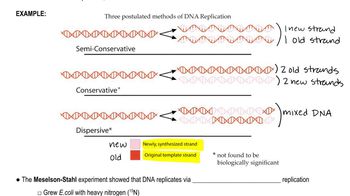DNA Replication
DNA replication is the biological process by which a cell makes an identical copy of its DNA. This occurs during the S phase of the cell cycle and involves unwinding the double helix structure, followed by the synthesis of new complementary strands using existing strands as templates. The process ensures that each daughter cell receives an exact copy of the parent cell's genetic material.
Recommended video:
Enzymes Involved in DNA Replication
Several key enzymes facilitate DNA replication, including DNA helicase, which unwinds the double helix, and DNA polymerase, which synthesizes new DNA strands by adding nucleotides complementary to the template strand. Other enzymes, such as primase and ligase, play crucial roles in initiating replication and joining Okazaki fragments on the lagging strand, respectively.
Recommended video:
Semi-Conservative Replication
DNA replication is described as semi-conservative because each new DNA molecule consists of one original (parental) strand and one newly synthesized strand. This mechanism was confirmed by the Meselson-Stahl experiment and is essential for maintaining genetic fidelity, as it allows for the accurate transmission of genetic information from one generation to the next.
Recommended video:
Semiconservative Replication
 Verified step by step guidance
Verified step by step guidance Verified video answer for a similar problem:
Verified video answer for a similar problem:

